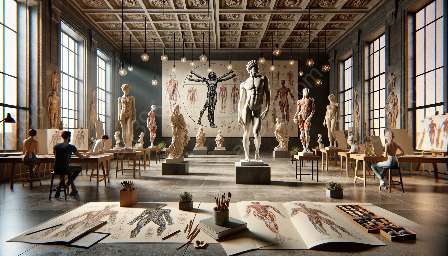Figure drawing is a fundamental aspect of art that has been influenced by various historical and cultural factors throughout the ages. Understanding the historical and cultural context surrounding figure drawing can provide valuable insights into the evolution of techniques, styles, and artistic anatomy.
Historical Influences on Figure Drawing
The history of figure drawing can be traced back to ancient civilizations such as Egypt, Greece, and Rome, where depictions of the human form played a significant role in art and culture. In ancient Egypt, figure drawing was intricately linked to religious beliefs and funerary practices, as seen in the elaborate depictions of the human figure in tombs and temples.
In ancient Greece, figure drawing reached new heights of anatomical accuracy and naturalistic representation, as artists like Polykleitos sought to capture the ideal proportions of the human body. The legacy of Greek figure drawing continued to influence artists throughout the Renaissance and beyond.
During the Renaissance, figure drawing experienced a revival, with artists such as Leonardo da Vinci, Michelangelo, and Raphael achieving unprecedented levels of anatomical precision and emotional expressiveness in their artworks. The study of human anatomy, facilitated by advancements in science and medicine, profoundly impacted the way artists approached figure drawing.
Cultural Influences on Figure Drawing
Across different cultures and time periods, figure drawing has been shaped by diverse artistic traditions, beliefs, and social norms. In Asia, for example, figure drawing in traditional Chinese and Japanese art often emphasized calligraphic lines, fluid gestures, and symbolic representations of the human form, reflecting the influence of philosophical concepts such as Taoism and Confucianism.
Similarly, the art of figure drawing in the Islamic world embraced intricate geometric patterns, arabesques, and stylized representations of the human figure, influenced by Islamic theology, poetry, and architecture. These cultural influences continue to inspire contemporary artists seeking to integrate diverse aesthetic traditions into their figure drawing practices.
Compatibility with Figure Drawing Techniques and Artistic Anatomy
The historical and cultural influences on figure drawing are inherently intertwined with figure drawing techniques and artistic anatomy. By studying the artistic practices of past civilizations and diverse cultural traditions, artists can gain new perspectives on gesture, proportion, and stylistic approaches to figure drawing.
Moreover, understanding the historical development of figure drawing can inform contemporary artists about the evolution of anatomical knowledge and the refinement of drawing techniques. By examining the works of master artists from different historical periods and cultural contexts, aspiring figure drawers can enrich their artistic vocabulary and expand their understanding of the human form.
Through the integration of historical and cultural influences, figure drawing techniques, and artistic anatomy, artists have the opportunity to create dynamic and culturally resonant figure drawings that reflect a deep appreciation for the rich tapestry of human creativity and expression.

